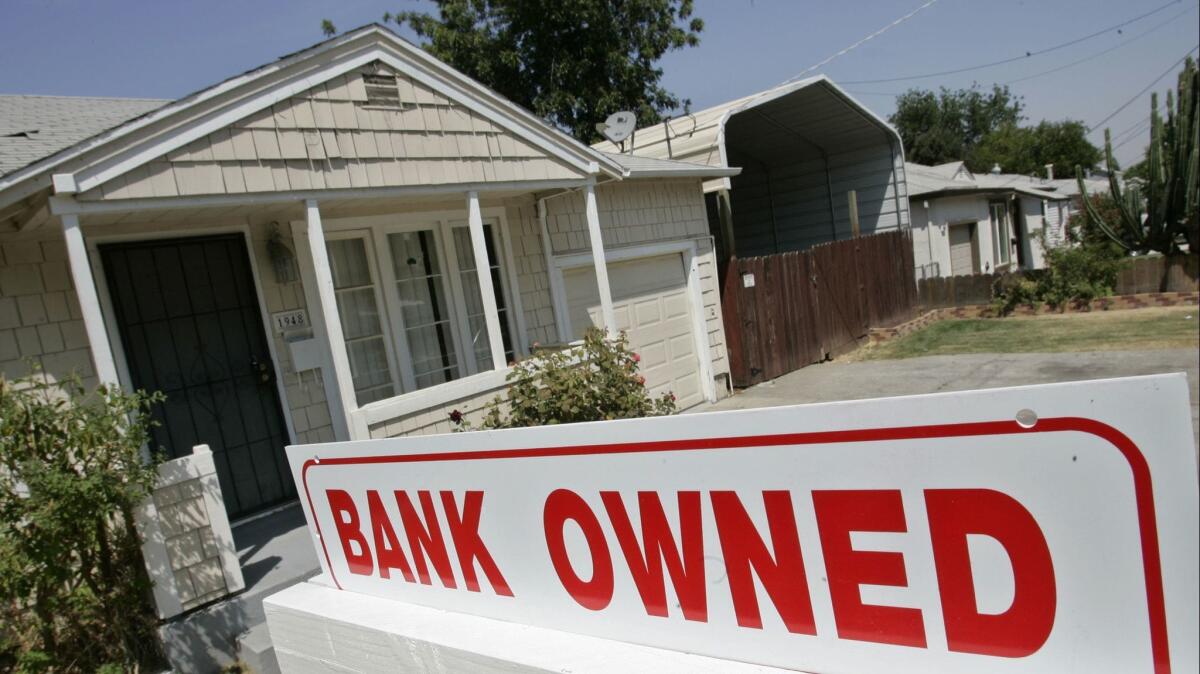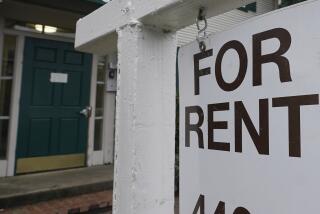Op-Ed: Flippers are using an end-around to kick tenants out of affordable housing. They need to be stopped

- Share via
If you want to make money in California, stake out a foreclosure sale.
A decade after the housing collapse crippled the global economy, there are still thousands of Californians who can’t make their mortgage payments and lose their homes. Shrewd investors can buy these properties at auction for far below market value, make a few improvements and then resell to make a fortune.
The plan only has one minor hitch: Many properties lost to foreclosure in California are occupied by tenants of the former owner, including tenants protected from eviction by state and local law. And no one wants to buy a flipped house with a bunch of tenants still living in it.
Under California law, getting a former owner out is no problem: all it takes is a three-day “notice to quit” and a modest fee to an eviction lawyer. But even in a state with minimal tenant protections, California renters in flipped properties have some rare and welcome insulations from immediate displacement.
Month-to-month tenants get between 30 and 90 days to leave a rental unit sold at foreclosure. Those on a fixed-term lease get to stay to the end of their term — however long that may be. Most importantly, tenants in rent-stabilized units in Los Angeles can never be evicted as a result of a foreclosure sale.The new owner is stuck with those tenants so long as they pay their rent and comply with their leases.
Property flippers are exploiting the misfortune of others. They shouldn’t be allowed to spread that misfortune to tenants.
Cagey flippers, however, have discovered a way around these foreclosure rules that is forcing tenants in affordable, and even rent-stabilized housing onto the streets.
When an eviction notice is served at a foreclosed property, flippers address it directly to the former owner — regardless of who lives there. Three days later, the flipper can file an eviction lawsuit against the former owner and unnamed “Doe” defendants. To avoid being evicted, tenants have to realize that they, and not just the former owner, are being sued and fight the case. They must file a “prejudgment claim of right to possession,” add themselves by name as defendants to the lawsuit, pay a filing fee, and go through litigation.
Not surprisingly, few tenants engage in this process. Because it is extremely difficult to find new housing once you have been previously evicted, most renters won’t risk naming themselves as defendants in an eviction proceeding. Instead, after the eviction suit is filed, they let flippers buy them out cheaply for a few thousand dollars of relocation money. Better to leave the property with some money and a clean record than get blackballed in the rental market.
Flippers get away with this because they have almost no enforceable legal obligation to investigate who actually resides at a property they purchase — and the speed of the eviction process leaves little room for courts to investigate, either.
Since January 2017, about 10,000 rental properties have been sold at foreclosure in California. Based on the state occupancy average of 2.5 occupants per unit, we can estimate that at least 25,000 California tenants have been affected by the threat of post-foreclosure eviction since the start of last year.
Enter the Fray: First takes on the news of the minute from L.A. Times Opinion »
Many of these tenants are in Los Angeles County, where 2,238 rental properties were sold at foreclosure in the past 21 months alone. Our client, Beatriz Salazar, lives in one of them.
Salazar received an eviction notice at her rent-stabilized duplex in Boyle Heights. It was addressed to the former owner of her unit, the person who had lost the property in foreclosure. The new owner encouraged Salazar to move out, even though he had a legal obligation to accept her as a tenant. Instead, she sought legal representation, added herself as a defendant to the lawsuit and convinced the new owner to dismiss the case.
Unfortunately, Salazar’s case highlights a secondary problem for tenants in foreclosure: if they are somehow able to withstand an eviction action, they may be left with an absentee landlord who has no interest in maintaining the building for the people who live there. The new owner of her unit has received citations for nearly 60 city code violations at the property since early this year that remain uncorrected.
Los Angeles could protect tenants in rent-stabilized properties by assessing high penalties against foreclosure buyers who take action to prematurely evict tenants of the former owner — especially if the buyer was presented with proof of tenancy early on. The state should also require proof that flippers have attempted to make face-to-face contact with occupants of the property before they are allowed to file an eviction lawsuit in a foreclosure purchase. Finally, local and state governments should supplement existing tenant protections and pass legislation that prevents foreclosure buyers from evicting tenants after foreclosure without just cause.
Property flippers are exploiting the misfortune of others. They shouldn’t be allowed to spread that misfortune to tenants.
Noah Grynberg and Tyler Anderson are co-directors of the Los Angeles Center for Community Law and Action, a community organization that provides legal services to poor people in Los Angeles.
Follow the Opinion section on Twitter @latimesopinionand Facebook
More to Read
A cure for the common opinion
Get thought-provoking perspectives with our weekly newsletter.
You may occasionally receive promotional content from the Los Angeles Times.






